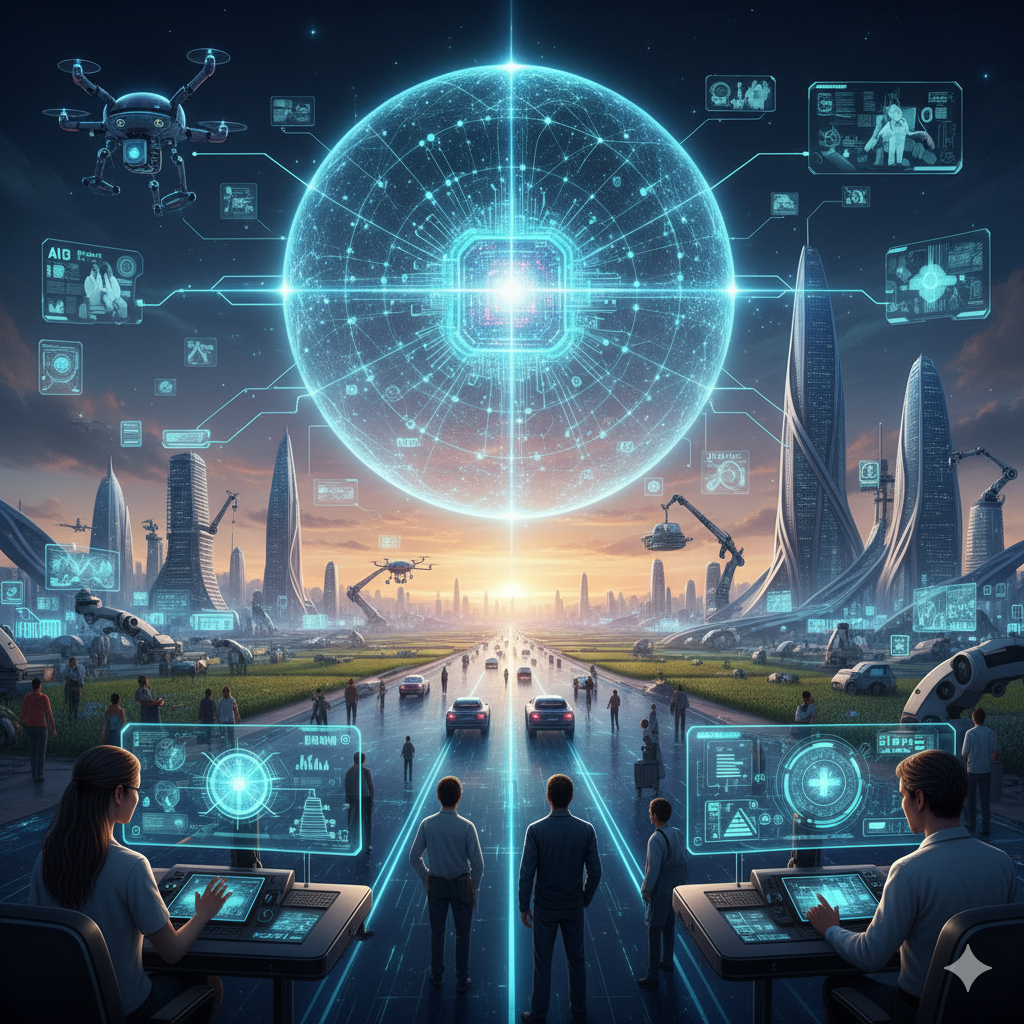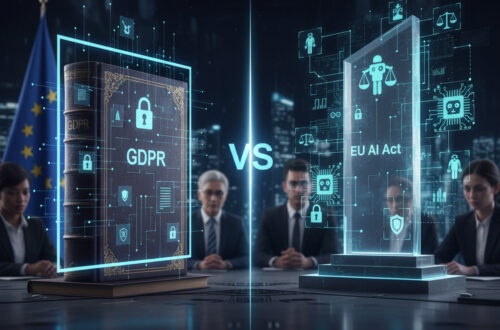Introduction — Why 2025 Feels Like a Turning Point
Artificial Intelligence (AI) has moved from research labs into everyday life and national policymaking. In 2025, AI is not just a tool: it’s an economic force, a subject of international regulation, and a transformational technology that affects jobs, health, democracy, and culture. This article walks through the concrete ways AI is shaping the future of humanity—what’s happening now, the risks to manage, and the policy and practical guardrails we need.
1. Policy & Governance: The Rules That Will Steer AI
Policymakers are no longer passively watching AI unfold — they are writing the rules. The European Union’s AI Act entered into force in 2024 and phases in obligations over the next few years; notably the Act’s general application schedule means major requirements for high-risk systems and general-purpose AI (GPAI) models come into force between 2025–2026, with some provisions fully applicable by 2026–2027. These rules aim to classify AI systems by risk level and set safety, transparency, and accountability obligations accordingly. Digital Strategy EUEuropean Parliament
At the same time, leading AI labs and companies agreed to the Frontier AI Safety Commitments (announced at the AI Seoul Summit and updated through 2025), promising stronger risk assessment, red-teaming, incident reporting, and governance for the most powerful models. These parallel private-sector commitments are an important complement to public regulation because they tackle operational safety practices that governments may not directly mandate yet. GOV.UK+1
Why this matters: policy timelines and industry safety pledges will determine how quickly and safely powerful AI systems are deployed across medicine, finance, and government services—and how much oversight and transparency the public can expect.
2. Economy & Jobs: Disruption, Augmentation, and New Opportunities
One of the clearest near-term impacts of AI is on the labor market. Major economic analyses show a sizable fraction of jobs are exposed to AI automation—IMF analysis and allied studies estimate roughly 40% of global employment faces exposure to tasks that recent AI systems can perform or assist with. The effect varies by country and sector: advanced economies may see high exposure in high-skilled roles but also the largest gains in productivity and wage premiums for AI-augmented workers. IMFCodingscape
Practical implications for workers and businesses:
- Many jobs will be restructured, not simply eliminated—AI automates tasks, not whole professions in most cases.
- Reskilling, data literacy, and tool fluency will be critical. Organizations and governments that invest in worker transition programs stand to benefit from AI-driven productivity growth.
- New roles—prompt engineers, model auditors, AI ethicists—are already appearing and will grow.
3. Education & Skills: Teaching for an AI-First World
Education systems must evolve quickly. The OECD and other international bodies emphasize that curricula should include not just tool training but new core competencies—critical thinking, data literacy, and meta-cognitive skills—so students can collaborate with AI rather than be replaced by it. Recent OECD guidance (2025) highlights that education systems should consider how to reorder curricula and integrate AI-aware pedagogy to prepare learners for a world where AI is a ubiquitous assistant. OECD
What schools & educators should do now:
- Introduce AI literacy across grade levels (how models work, their limitations, and ethical considerations).
- Train teachers to use AI as a pedagogical assistant: adaptive learning, assessment automation, and differentiated instruction.
- Ensure equitable access so AI-enablement does not widen existing educational inequalities.
4. Science & Medicine: Faster Discovery, Better Care
AI is accelerating scientific discovery and transforming healthcare. Landmark AI advances—like DeepMind’s AlphaFold family—have radically improved our ability to predict protein structures and molecular interactions, enabling faster target identification and drug design. AlphaFold 3, for example, advanced the accuracy and interaction-prediction capabilities that researchers use to probe biological mechanisms and accelerate therapeutics research. These capabilities shorten the time between insight and actionable medical research. blog.googleGoogle DeepMind
In clinical settings, AI assists with diagnostic imaging, triage, and personalized treatment planning. But medical deployment requires rigorous validation, explainability, and regulatory approval to avoid harm and unequal outcomes.
5. Democracy, Truth & Culture: Information, Misinformation, and Trust
Generative AI has unleashed new creative tools and new misinformation risks. AI can create plausible text, images, audio, and video at scale—raising concerns about deepfakes, coordinated disinformation, and erosion of public trust. The policy and industry moves discussed earlier (transparency requirements, provenance markings, and incident reporting) aim to restore some of that trust by making AI-generated content traceable and accountable.
Practical steps for individuals and platforms:
- Adopt content provenance standards (e.g., C2PA) so audiences can verify whether media is AI-generated.
- Improve media literacy so users learn to check sources and metadata.
- Platforms should combine detection, labeling, and friction for uncertain content to slow the spread of harmful misinformation.
6. Everyday Life: How You Will Notice AI First
AI’s impact is already visible in daily consumer experiences:
- Personal assistants that summarize emails, plan travel, or automate tasks.
- Health triage and wellness apps that pre-screen symptoms and flag urgent issues.
- Personalized services—from shopping recommendations to customized news digests—tailored by models analyzing user behavior.
These conveniences bring real benefits, but they also raise privacy trade-offs. Personal data governance and clear consent are essential to keep these services trustworthy.
7. Risks That Need Urgent Attention
AI brings major benefits—but it also amplifies risks that need proactive management:
- Bias and inequality: Models trained on historical data can perpetuate unfairness unless developers deliberately correct for it.
- Safety & misuse: Powerful capabilities can be repurposed for harmful use—from automated cyberattacks to biotechnical misuse—hence the emphasis on frontier safety practices.
- Concentration of power: Compute, data, and talent are concentrated in a few firms and nations, which can limit equitable benefit distribution.
- Environmental footprint: Training large models consumes energy; transparency about emissions and efficiency improvements are necessary.
Addressing these risks means combining regulation, industry self-governance, research transparency, and international cooperation.
8. Practical Guardrails Organizations Should Adopt Now
Whether you lead a small company or a large public agency, implementing practical measures today will reduce future risks and unlock benefits:
- Map AI use to risk tiers (following EU-like risk frameworks): identify high-risk use cases and apply stricter controls. Digital Strategy EU
- Adopt human-in-the-loop controls for decisions affecting safety, rights, or finances.
- Maintain model provenance & versioning so audits and incident responses are possible.
- Run red-team exercises and third-party audits for high-impact models, echoing frontier safety best practices. GOV.UK
- Invest in workforce transition—training staff in AI tools and ethics to remain competitive.
9. Three Plausible 2030 Scenarios
Acceleration: Widespread AI adoption boosts productivity, creates industries, and lifts living standards—but only where governance and reskilling investments are made.
Patchwork: Countries and firms diverge: some regions harness AI effectively while others lose ground due to lack of data, investment, or policy. Inequality widens.
Backlash: Misuse, market concentration, and social harms result in strict controls or moratoria in many jurisdictions, slowing benefits but reducing harms.
Which path we take depends on policy choices, corporate behavior, and public engagement today.
Conclusion — Human Agency Matters
AI is a transformative tool that can expand human capabilities and address grand challenges—if we build appropriate guardrails, invest in people, and govern responsibly. The technology does not determine the future; our policies, institutions, and civic choices do. If societies combine innovation with strong safety and fairness rules, AI can be a powerful force for human flourishing.
Call to action: Learn more about AI ethics, sign up for community discussions, and support policies that insist on transparency, fairness, and inclusive benefit sharing.
Sources & Further Reading (key load-bearing citations)
- EU AI Act implementation and timeline. Digital Strategy EUEuropean Parliament
- Frontier AI Safety Commitments (AI Seoul Summit updates). GOV.UK+1
- IMF analysis on jobs exposed to AI (~40% of global employment exposure). IMF
- DeepMind / AlphaFold 3 advances in protein structure & interaction prediction. blog.googleGoogle DeepMind
- OECD guidance on education and AI (2025).





